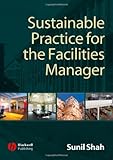| Title: | Sustainable Practice for the Facilities Manager |
| Categories: | Construction |
| Authors: | Sunil Shah |
| ISBN-10(13): | 1405135573 |
| Publisher: | Wiley-Blackwell |
| Publication date: | 2007-01-19 |
| Number of pages: | 320 |
| Language: | English |
| Picture: |

|
| Review: |
First appearing in 2007, this book breaks new ground by providing a successful integration of the already established areas of Facilities Management and Sustainability. The book delivers practical guidance and information that enables facilities managers to bring sustainability into their everyday activities. Written with the end-user in mind, this is achieved by skilful use of a broad overview of the key principles combined with referencing of relevant material. The result acts as a first point of reference for those who want to deliver better performing facilities. One of the book's most significant contributions to practice is that it equips the facilities manager with knowledge of both the building life cycle and of the needs of the user. The facilities manager is thus empowered to participate with confidence in the decision-making processes alongside fellow professionals. The book's structure covers four areas, each as an individual chapter: Sustainable development and facilities management. An introduction to the concepts; The book's broad overview of the subject may leave the author open to the potential criticism of trying to present too wide a coverage with consequently too little provision of detail. However, I would take the view that this breadth of coverage is the very strength of the book, conveying the landscape of the discipline whilst pointing the way to more detailed information elsewhere. This is reinforced by the excellent use of selected and concise case studies (covering examples of good and bad). These case studies cause the reader to consider the practical implications of the subject matter and to seek further knowledge as required. The result is a desire to do a better job and not repeat mistakes made elsewhere. As sustainable practice becomes, of necessity, the norm in all aspects of society, facilities managers will find this book a useful point of reference in their daily work. Those new to the field will be hard-pressed to come across a better overview of the subject. For students of facilities management and related subjects this book represents an important introduction to and treatment of the topic and one that should remain useful throughout their professional careers. Professor DL Loveday April 2008 |



